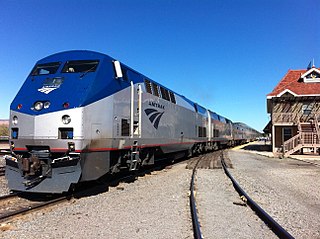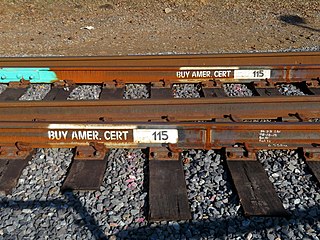
The United States Department of Transportation is one of the executive departments of the U.S. federal government. It is headed by the secretary of transportation, who reports directly to the president of the United States and is a member of the president's Cabinet.

The Tren Urbano is a 10.7-mile (17.2 km) automated rapid transit system that serves the municipalities of San Juan, Guaynabo, and Bayamón, in Puerto Rico. The Tren Urbano consists of 16 stations operating on 10.7 miles (17.2 km) of track along a single line. In 2023, the system had a ridership of 2,738,100, or about 10,200 per weekday as of the fourth quarter of 2023.

The Research Triangle Regional Public Transportation Authority, known as GoTriangle, provides regional bus service to the Research Triangle region of North Carolina in Wake, Durham, and Orange counties. The GoTriangle name was adopted in 2015 as part of the consolidated GoTransit branding scheme for the Triangle. In 2023, the system had a ridership of 1,735,700, or about 6,300 per weekday as of the fourth quarter of 2023.

Miami-Dade Transit (MDT) is the primary public transit authority of Miami, Florida and the greater Miami-Dade County area. It is the largest transit system in Florida and the 15th-largest transit system in the United States. As of 2023, the system has 80,168,700 rides per year, or about 277,400 per weekday in the fourth quarter of 2023. MDT operates the Metrobus with their paratransit STS systems run by LSF. MDT also operates two rail transit systems: Metrorail and Metromover.

The American Public Transportation Association (APTA) is a nonprofit group of approximately 1,500 public and private sector member organizations that promotes and advocates for the interests of the public transportation industry in the United States.

Paratransit or Intermediate Public Transport, is a type of transportation services that supplement fixed-route mass transit by providing individualized rides without fixed routes or timetables. Paratransit services may vary considerably on the degree of flexibility they provide their customers. At their simplest they may consist of a taxi or small bus that will run along a more or less defined route and then stop to pick up or discharge passengers on request. At the other end of the spectrum—fully demand responsive transport—the most flexible paratransit systems offer on-demand call-up door-to-door service from any origin to any destination in a service area. In addition to public transit agencies, paratransit services may be operated by community groups or not-for-profit organizations, and for-profit private companies or operators.
The Urban Mass Transportation Act of 1964 provided $375 million for large-scale urban public or private rail projects in the form of matching funds to cities and states. The Urban Mass Transportation Administration was created. It provided capital grants for up to 50% of the cost of transit improvements.
The Illinois Department of Transportation (IDOT) is a state agency in charge of state-maintained public roadways of the U.S. state of Illinois. In addition, IDOT provides funding for rail, public transit and airport projects and administers fuel tax and federal funding to local jurisdictions in the state. The Secretary of Transportation reports to the Governor of Illinois. IDOT is headquartered in unincorporated Sangamon County, located near the state capital, Springfield. In addition, the IDOT Division of Highways has offices in nine locations throughout the state.
The Massachusetts Department of Transportation (MassDOT) oversees roads, public transit, aeronautics, and transportation licensing and registration in the US state of Massachusetts. It was created on November 1, 2009, by the 186th Session of the Massachusetts General Court upon enactment of the 2009 Transportation Reform Act.

Skyline is a light metro system in the City and County of Honolulu on the island of Oʻahu, in the state of Hawaiʻi. Phase 1 of the project opened June 30, 2023 and lies entirely outside of Urban Honolulu, linking East Kapolei and Aloha Stadium. Phase 2, connecting to Pearl Harbor and Daniel K. Inouye International Airport before reaching Middle Street, is anticipated to open in mid-2025. The final phase, continuing the line across Urban Honolulu to Downtown, is due to open in 2031. Its construction constitutes the largest public works project in Hawaiʻi's history.

The United States is serviced by a wide array of public transportation, including various forms of bus, rail, ferry, and sometimes, airline services. Most established public transit systems are located in central, urban areas where there is enough density and public demand to require public transportation. In more auto-centric suburban localities, public transit is normally, but not always, less frequent and less common. Most public transit services in the United States are either national, regional/commuter, or local, depending on the type of service. Sometimes "public transportation" in the United States is an umbrella term used synonymously with "alternative transportation", meaning any form of mobility that excludes driving alone by automobile. This can sometimes include carpooling, vanpooling, on-demand mobility, infrastructure that is oriented toward bicycles, and paratransit service. There is public transit service in most US cities.
The Monroe County Transit Authority (MCTA), also known as the Pocono Pony, is a public transportation service located in Monroe County, Pennsylvania. It provides rural and inter-city fixed route bus and paratransit service within the county. MCTA is funded in part by PennDOT, the Federal Transit Administration, local match and farebox revenue.
The HUD Reports were a series of studies in mass transit systems, funded by the Urban Mass Transportation Administration (UMTA) department of the United States Department of Housing and Urban Development (HUD). The HUD reports were extremely influential in the development of the personal rapid transit (PRT) concept, small pod-like vehicles that automatically travel from point-to-point in extended networks. Their publication in early 1968 sparked off PRT development projects at dozens of companies around the world. In spite of intense interest in the early 1970s, political winds shifted and today there is only one HUD-inspired PRT system in commercial operation, the Morgantown PRT in West Virginia.

Pocatello Regional Transit (PRT) is the primary provider of mass transportation in Southeast Idaho and is a department within the City of Pocatello (Public Transit Department). Transit services being provided by PRT in Idaho Transportation District #5 have been greatly assisted by County and Municipal organizations, Idaho Transportation Department (ITD), and the Federal Transit Administration (FTA). Residents & visitors within the service area are all eligible to ride and the welcome is extended to come & "TAKE YOUR SEAT" on the bus.

Proterra Inc. was an American electric vehicle and powertrain manufacturer based in Burlingame, California. The company designed and manufactured battery electric transit buses, battery systems for other heavy-duty vehicle builders and charging systems for fleets of heavy-duty vehicles. Founded in 2004, it became a public company in June 2021. The company delivered 199 new transit buses and battery systems for 1,229 vehicles in 2022. The company filed for Chapter 11 bankruptcy in August 2023. In November, its assets were split into three divisions and sold off to Volvo Battery Solutions, Phoenix Motorcars, and Cowen Equity.

Assembly station is a rapid transit station in Somerville, Massachusetts. It serves the MBTA's Orange Line. It is an infill station, located on a section of the Orange Line that has been active since 1975. The station, which opened on September 2, 2014, was the first new rail station on the MBTA subway system since 1987. Assembly station is meant to provide convenient access to Assembly Square - a major retail and residential development located on the site of a former Ford assembly plant - and the adjacent Assembly Square Marketplace.

Section 165 of the Surface Transportation Assistance Act of 1982 is a section of the larger STAA that deals with purchases related to rail or road transportation. Unlike the similarly titled Buy American Act (1933), the Buy America Act applies only to purchases related to rail or road transportation, such as the construction of highways, railways, or rapid transit systems. The 1982 provisions also apply to purchases made by third-party agencies, using funds granted by agencies within the United States Department of Transportation.
CFR Title 49, Parts 600 thru 699 - Federal Transit Administration (FTA) is one of twelve chapters comprising the United States Code of Federal Regulations (CFR), Title 49, consisting of a unified body of regulations applying to specific functions and activities under the control of the FTA. This chapter itself consists of 20 parts covering FTA organization, functions and procedures for its offices and programs.
The East San Fernando Valley Light Rail Transit Project, formerly the East San Fernando Valley Transit Corridor Project, is a transit project which is proposing the construction of a light rail line on the east side of Los Angeles's San Fernando Valley, running on a north/south route along Van Nuys Boulevard and San Fernando Road.

The Inglewood Transit Connector Project is a proposed 1.6-mile (2.6 km) fully elevated, automated people mover system in Inglewood, California, that will connect the Downtown Inglewood station on the K Line of the Los Angeles Metro Rail system to the major sports and entertainment venues in the city: Kia Forum, SoFi Stadium, Hollywood Park Casino and the under-construction Intuit Dome. The project was planned to break ground in 2024 and begin operations in late 2027, ahead of the 2028 Summer Olympics that will use some of the venues. However, the Federal Transit Administration (FTA) currently reports that the transit connector will not open for revenue service until early 2030.














